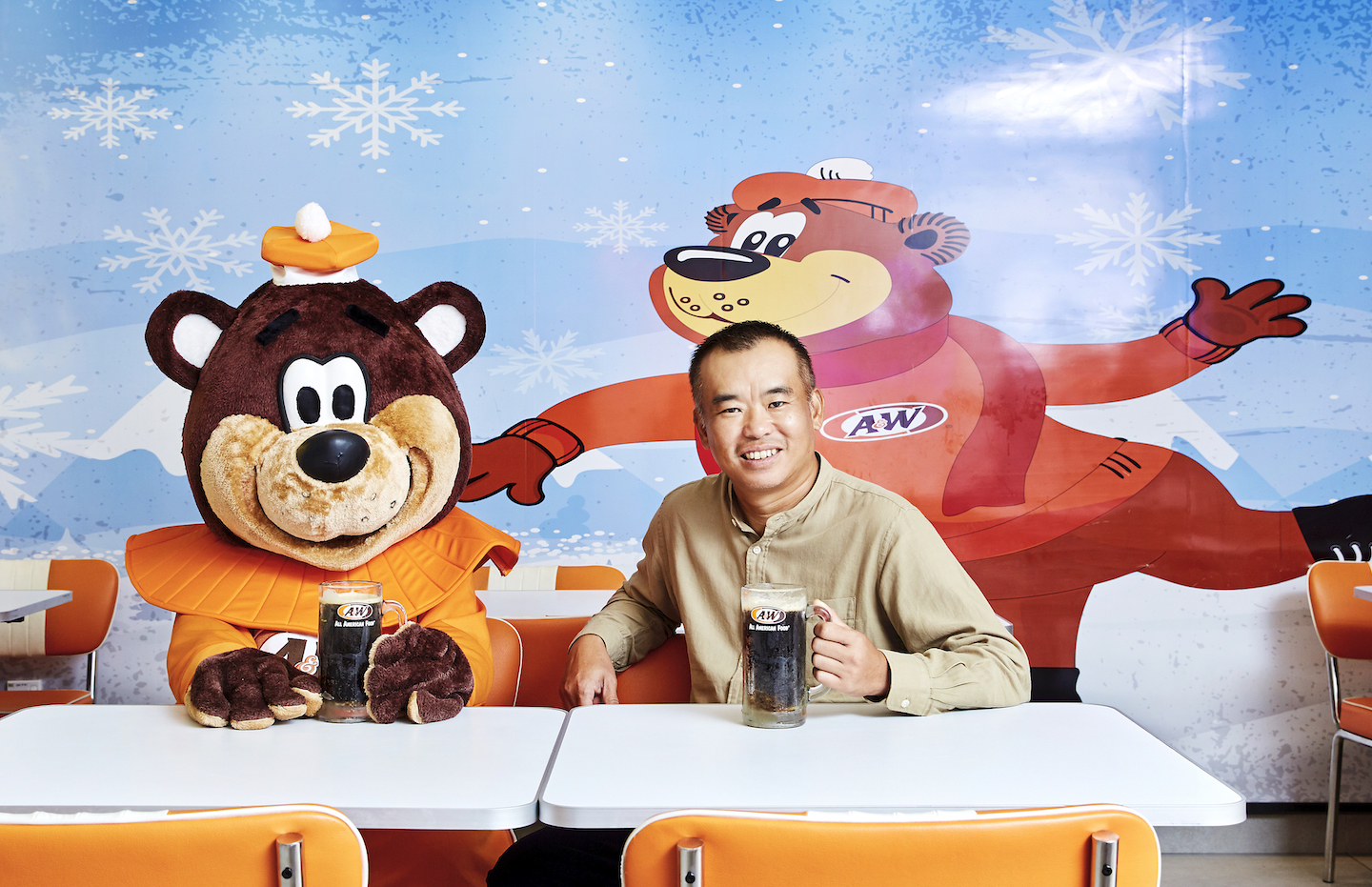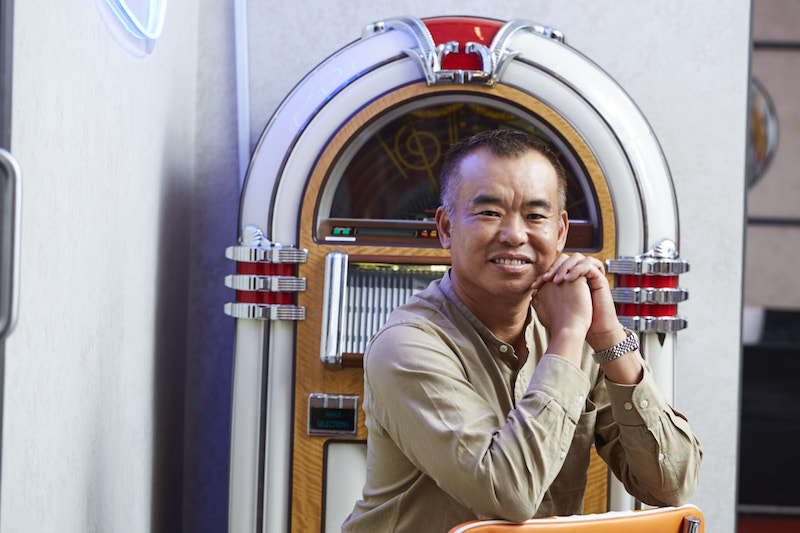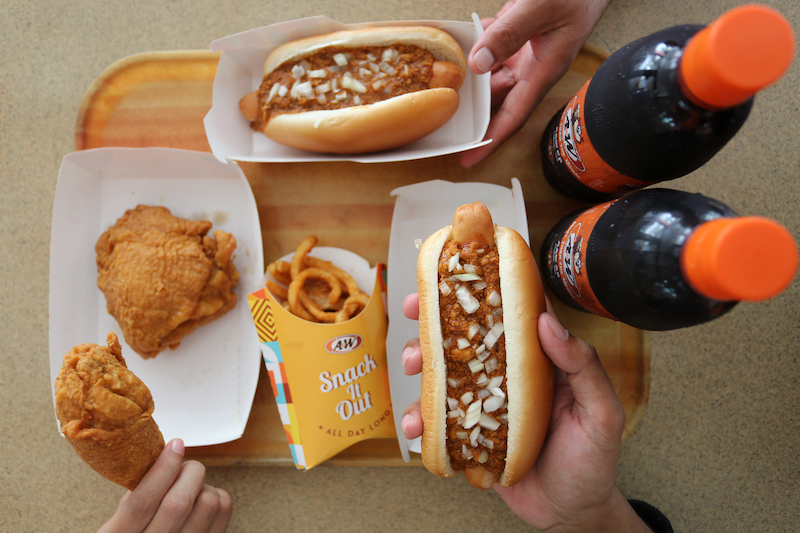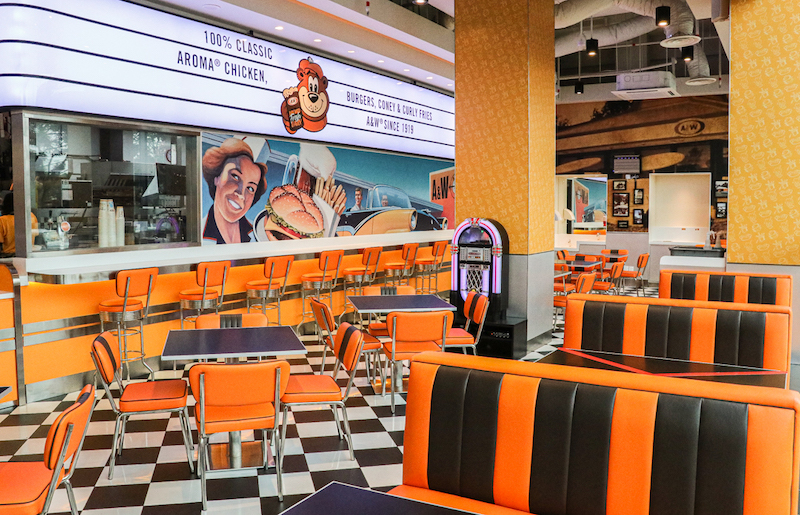
Ang is ambitiously targeting 100 stores nationwide in the next couple of years (Photography by SooPhye)
Frosty mugs of root beer have been an effervescent pick-me-up since 1919, when Roy Allen and Frank Wright collaborated on their acronymous root beer business A&W. The soft drink, identified by its foamy head, had been around for over four decades, but it was the duo’s method of freezing the mugs prior to serving that distinguished their product and immortalised a cool brand experience.
Over a century later, those frosty mugs remain an A&W icon and are making a comeback in Malaysia. A&W is chiselled in the annals of history for being the first fast food restaurant in the country when it opened in 1963. Curious customers flocked to the maiden outlet on Jalan Tuanku Abdul Rahman, Kuala Lumpur, for a taste of American culture, expressed in the form of burgers, coney dogs, waffles and the drink that started it all, now available as a creamy float with a scoop of vanilla ice-cream. The franchise expanded nationwide, adding on drive-thrus, playground sets and private rooms for birthday parties. The latter quickly became synonymous with appearances by The Great Root Bear mascot, known as Rooty.
Decades passed, and the young people who patronised the franchise in its early days were soon bringing their children, and then their grandchildren, by for celebrations or special occasions. But it was a different world by then. Sheer ubiquity and variety meant fast food joints were beginning to lose their lustre and A&W blurred into the crowded landscape of choices. Unlike many of its competitors, few efforts were taken to ensure the local franchise remained relevant, and the once-beloved brand soon seemed to survive purely on the nostalgia of the generations who could still remember its glory days.
And so it was, until George Ang, CEO of Inter Mark Resources Sdn Bhd, bought over the franchise in September 2018.
That first foray
When Ang acquired his motorcycle licence at 16, he could not have predicted he would someday be using it to deliver pizza. As a college student in the late 1980s, he was looking to supplement his pocket money and took up a part-time job with Pizza Hut. It was the first restaurant in the country to offer deliveries and Ang was attached to the Taman Tun Dr Ismail branch in KL, where he earned RM2 per hour for dropping off orders to the homes of hungry customers. Here, he learnt two important lessons that would serve him for life: Being the most hardworking person in the room could be very rewarding and fast food is not rocket science.
_s1a4002_2.jpg

“Unlike the waitstaff, who had to pool tips with everybody, delivery boys could keep all their tips,” recollects Ang. “I quickly realised that if I worked hard, I could earn more, especially on rainy days. Whenever there were thunderstorms or heavy rain, the other delivery boys would send an order and then seek shelter somewhere until the downpour eased. Orders would be piling up at the restaurant, so I’d pick up several orders at a time and deliver them. When you turn up at these bungalows rain-soaked with hot pizzas in hand, you tend to get generously tipped. So, RM2 an hour would become RM8 or RM10 per hour. I saw the opportunity created by rainy days.”
Ang was a finance and economics major who aspired to be a high-flying businessman in the finance world, but even when his tertiary education took him to the University of Western Australia, he continued to work part-time in the food and beverage (F&B) industry. Experience taught him that you do not need expertise to run a fast food restaurant. Rather than relying on the skill of a chef, consistency and quality are built into stringent standard operating procedures (SOPs) that could be replicated anywhere by anyone.
This knowledge burrowed in the back of his mind while he went on to pursue a career in banking, working first at OCBC Bank and then at BNP Paribas in Singapore, where he enjoyed the perks and privileges that came with being an expat. It was not in his nature to answer to others, however, and entrepreneurship continued to beckon. At 27, he left the rat race, co-founded Revenue Valley Sdn Bhd with two partners and purchased the franchise for New Zealand fish-and-chips eatery The Fish Shop.
This was in the immediate aftermath of the 1997 financial crisis, which, while devastating for many, also created rare opportunities such as low rental rates. Ang opened The Fish Shop in Mid Valley for a steal at RM5 per sq ft, and another outlet in Subang Parade. Bottom lines were healthy enough and things went well for a couple of years until the New Zealand-based founder withdrew support from Malaysia and the local franchise collapsed.
Store owners were left grasping at straws and many reinvented offerings to entice customers. Ang and his partners decided on a rebrand altogether and developed The Manhattan Fish Market name, inspired by one of the two biggest fish markets in the world (the first is the former Tsujiki market in Japan and the second, Fulton in Lower Manhattan, New York). It was positioned as an elevated dining experience with a wide variety of seafood and preparation techniques. Revenue more than doubled and they expanded the chain, taking over the liabilities of other The Fish Shop franchise holders to convert their restaurants into The Manhattan Fish Market name until the latter received the necessary approval to become a franchise in its own right.
Seafood was not their only playing field. They also developed homegrown brands such as NY Steak Shack, and obtained the franchising for American casual dining chain restaurant Tony Roma’s, as well as Popeye’s Louisiana Kitchen (in Singapore). Expansion, both nationally and regionally, was swift and interest in the group’s portfolio deepened, leading to a sale to private equity firm Ekuinas in 2012.
“This business is all about scalability,” says Ang. “It’s a challenge to grow from one restaurant to five, but a different thing altogether to grow from five to 20 or 40. We realised we would have to keep acquiring loans to reinvest into the business if we wanted to grow, or we could get a partner or sell. When Ekuinas came in with a good valuation, we decided to take their offer. We still hold a 15% stake and I’ve stayed on as a director, but we are not involved with operations.”
A knack for turnarounds
Letting go of his responsibilities at Revenue Valley did not mark the end of Ang’s interest in F&B. Instead, he founded Inter Mark Resources, which now operates Subway and recently attained coffee brand Jamaica Blue. However, it gained most prominence in September 2018 when it successfully acquired the A&W franchise from KUB Malaysia Sdn Bhd.
The once-exhilarating brand had largely been relegated to a relic of the past with its rundown outlets and painfully outdated facilities. Ang, however, had a personal interest in seeing A&W flourish once again. As a child, this son of a pastor and a housewife was thrilled at every visit to the Petaling Jaya drive-in outlet where he could have his favourite coney dog and root beer float. Sentiment should not get in the way of business decisions but he was convinced all was not yet lost.
“There were over 30 outlets at the time and the franchise was just about breaking even,” he says. “KUB had not invested in remodelling or maintenance, so there was spoilt equipment just sitting around and the stores were in desperate need of refurbishing. Quality had plummeted and service was poor because staff were insufficient in number and insufficiently trained. It was also almost obsolete in practice — A&W was the only fast food chain to still run on 100% cash, since it had no credit card facilities. This was in 2018! It was like something out of the 1960s.
“When I took it over, I thought to myself, okay, this is very badly run but there’s strong brand awareness and core products that we can work with. A&W is the only fast food brand in Malaysia, maybe even the world, to produce its own soft drink. Everyone else uses Pepsi or Coca-Cola products, which you can get from any 7-Eleven or convenience store. But if you want a root beer, you come to A&W. It also has food items no other fast food chain carries, such as fresh waffles, curly fries and coney dogs.”
img_9517.jpg

(Under Jakim, the Department of Islamic Development’s guidelines, the terms “coney dog” and “root beer” can no longer be used lest they confuse Muslim patrons. Instead, at A&W, these products are now officially known as Coney Beef or Coney Chicken, and RB respectively.)
“One of the things I immediately discovered was that KUB had phased out the cold mugs in most places,” continues Ang. “At restaurants with al fresco seating, such as the A&W outlets along the PLUS Highway rest stops, there was a high rate of pilferage, with customers taking their trays out and stealing the mugs. These were then replaced with paper cups, which spoils the experience. We also keep our mugs in speciality freezers for that frosted character, but most of the freezers were spoilt and had never been repaired. When customers complained that their drinks weren’t cold, staff would add ice, which then diluted the RB. So, one of the first things I did was to have all the freezers repaired or replaced to bring back the frosted mugs.
“I also realised that, over the years, fresh chicken had been replaced with frozen, owing to logistics or supply issues, which had a severe impact on the quality of the food. We have since changed it back to fresh and customers tell us the quality has markedly improved since.”
While the iconic dishes and drinks will always be staples at A&W, product innovation is once again alive and well to keep regulars interested and discover potential new menu mainstays. Recent experiments to receive the thumbs up include the Lily Chili Aroma Chicken,coated with a sweet lily chili sauce, the tropical-themed Hula Hula burger featuring a mixed spice island sauce, and the Korean-inspired Annyeong Pedas Oh Spicy Chicken! with a fiery kick for those who can handle the heat.
Product offerings taken care of, with SOPs in place to keep innovation constant and quality consistent, Ang then turned his attention to the shabby environs. He first fixed the “low-hanging fruit”. Solid tech-based infrastructure was introduced to bring the brand into the digital age via cloud-based enterprise resource management and cashless payment systems to facilitate credit card and e-wallet transactions. A&W had also never ventured into the delivery game; partnerships with Grab and Food Panda were immediately established, and there is now talk of an in-house delivery service.
Next were the interiors. The outlet at Seventeen Mall in Petaling Jaya was the first to unveil the new brand aesthetic, a rollicking retro chic theme that recalls the groovy vibes of the 1960s to the 1980s. The diner concept was resurrected in this million-dollar makeover, with deliberately Instagrammable booths and bar seats, and funky posters and a working juke box that bring alive the era’s pop cultural cues. The idea is to refurbish all outlets to this standard while new outlets — Ang is ambitiously targeting 100 stores nationwide in the next couple of years — will all wear these colourful codes.
This dual-pronged approach, tapping into the past while referencing the present, targets the two major customer demographics: the older generation, among whom brand awareness is strong, and the youngsters who have little to no idea what A&W is about.
“Our brand consultants deliberated anchoring our strategy on nostalgia but market research showed us that not only is the above-40 crowd well aware of us, it’s also a shrinking market, in terms of both market size and consumption volume,” says Ang, sitting in the private section of the gleaming outlet at Sunway Pyramid. “It’s the under-40s who eat out more, and more frequently. Our focus therefore is on bringing in this crowd, and nostalgia is not the most effective sentiment to play on. Instead, our strategy going forward is to invest in new products and better marketing.”
img_4030_1.jpg

Trends that will be incorporated into future propositions include healthier options for adults and children alike. A&W is in talks with suppliers about plant-based meat patties that closely resemble the taste of real meat.
“For children, we have the Beary Meals but parents looking to limit sugar intake are hesitant about getting them the RB,” he continues. “The root beer is our winner but it’s also our weakness in that sense, as we never used to offer other drink options. We’re now considering choices such as Milo, Ribena or orange juice that are perceived to be healthier.”
In terms of settings, Ang is also looking to scale the brand further by increasing drive-thru and drive-in outlets in response to changing consumer preferences.
“We don’t have to be the biggest fast food chain in Malaysia; it’s hard for us to compete against giants like KFC and McDonald’s,” he says. “Instead, I’m looking at how we can someday achieve the most sales per sq ft, and that’s very possible.”
People-first leads to profit
In the short time since Ang acquired A&W, and amid the unexpected obstacles thrown up by the Covid-19 pandemic, the company has grown to over 60 outlets. The only way this has been possible is by making the right investments in human capital.
“People are your biggest opportunities and challenges,” he says. “If you can get the right people in the right places, and get them on the right track, you can go very far very fast. This year, our emphasis is on service and hospitality — for now, customers visit A&W for its products, not the customer experience. But that is poised to change as we get the service up to speed.”
Operations are another make-or-break area and the management is doing its best to pave clear career paths for promising talents as well as to lead by example. Key roles have defined progression plans and a wealth of resources are poured into mentorship, development and leadership workshops and programmes. A&W’s core values are not often talked about, but the RIBS (Results-oriented, Integrity, Being better at being better, and Servant leadership) formula paints the picture of a company that values holistic development.
“Each element is important but I especially appreciate the last two: being better at being better underscores the significance of constant learning and growth, while servant leadership underlines that the role of the leader is to serve,” says Ang. “I’m sometimes asked whether I practice an open-door policy at work, to which I reply, ‘What door?’ I don’t have a door, anyone can come up to me for a chat anytime. And, usually, they approach me when they need help, and my responsibility then is to serve them. We have this fun practise where every quarter, the leadership team in the head office takes over service at an outlet that has performed exceptionally well. We pour root beer, fry chicken, and work alongside or even serve the staff there. It makes them feel seen and recognised, and it also reminds us of the fundamental things, no matter how high we climb. This is a very grounded business, and you cannot lead from an ivory tower.”
Years ago, in an effort to be approachable and accessible to his ever-increasing and ever-scattered staff, Ang began writing weekly notes in which he would share announcements, musings, observations or even personal lessons or experiences. These notes of varying lengths would be emailed to staff every Friday, gaining the affectionate handle of Friday Food Prints. During the Movement Control Order last year, he began sharing some of these insights with friends who decided to compile them on his behalf. Friday Food Prints: Stories on Food, Franchise & Friends was published as a book and might soon be available for public purchase.
“Some of my role models in the business are Ray Kroc, who purchased McDonald’s from the founding brothers and is credited with its global expansion, and Subway founder Fred DeLuca, whose sandwich shop — which he started at age 17 — became the world’s largest privately owned chain in terms of store numbers,” says Ang, who spends his free time on the fairways. He admits he is competitive on the green, and likes the game of golf because you never really master it in its entirety, ensuring you are in perpetual competition with yourself.
“[Kroc and DeLuca] had several traits in common, and among them was the prioritising of people,” he continues. “This is a people-centric business and people are how you rise or fall. Friday Food Prints was a way for our staff to know I’m not just an anonymous entity somewhere in the background. People need to know you to trust you, and trust is the only way forward.”
This article first appeared on May 31, 2021 in The Edge Malaysia.


